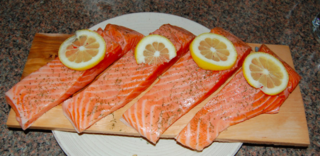Omega-3
Practical Tips for Balancing the Omega 6-to-3 Ratio
How to increase the omega-3 and decrease the omega-6 in the diet.
Posted February 5, 2017

In the last post, I talked about some fascinating new research showing there may be an advantage to be more careful about balancing the ratio of omega 3 fatty acids to the omega 6 fatty acids in the diet. Both are polyunsaturated fatty acids with biologically active roles in the body. It’s easy enough to chat about in the abstract, but how much omega 6 do we really get compared to omega 3, and how much to we move to correct the imbalance?
First off, I’m no dietitian, though I talk to my patients about food and mood all the time. One thing I’ve found over the years is that it’s usually not particularly helpful to suggest plans tracking and planning every last milligram of food. Sometimes it’s useful to track for a few days to get a sense of the overall diets, but pictures of meals looking at components, variety, and color will often tell you just as much as putting the meals into a tracker app without all the extra work. Therefore my advice tends to be more general than a planned blueprint of what to eat for each meal, and this post will follow that trend.
The components of food are grouped into fats, carbohydrates, protein, and micronutrients, but each of these larger groups are subdivided. All fats are not equal, nor all carbohydrates. Even the subgroups of omega 6 and omega 3 polyunsaturated acids have smaller subgroups, and all omega 6 and omega 3 aren’t made equal. For example, there’s some evidence that omega 6 or 3 in the form of phospholipids (such as in egg yolks) are quite differently used in the body than omega 6 from say, peanut oil, while omega 3 in the form of ALA from flax is less useful than the longer chain forms, EPA and DHA.
These polyunsaturated lipids are stored on cell membranes, and omega 3s are so important that they will tend to displace omega 6…so having a sufficient amount of omega 3 will protect, somewhat, from having a diet vastly slanted in favor of omega 6. Therefore, I believe the most important piece to get straight is to add good sources of omega 3 to the diet, then think about taking away the most egregious sources of omega 6. My “egregious” I mean foods that have little other nutritional value, so are mostly carriers of empty carbohydrates and fats (for example, cheese puffs).

The best sources of omega 3s for the brain are a combination of EPA and DHA, which means fatty fish. However, we can make some EPA and DHA from a precursor ALA found in flax seeds, chia seeds, and nuts. Here are some of the best food sources (think of 2-3 servings of these a week):
fish and seafood: particularly salmon, mackerel, sardines, herring, caviar, oysters, anchovies. The small fish and oysters are also high in other minerals needed for the brain, such as zinc.
omega 3 eggs (hens are fed flax seeds): high in ALA with just a bit of DHA, but one egg will give you approximately the same total omega 3 as three quarters of an ounce of fatty fish.
flax seeds, chia seeds: give you ALA. We can metabolize ALA into longer chain fatty acids needed by the brain, but this process depends on genetics and environment.
nuts such as walnuts have a good amount of omega 3 in them, but they also tend to have a lot of omega 6, so they can be a wash or even worsen the overall balance in the diet. I wouldn’t look to them as major sources of omega 3 for this reason unless you are a strict vegetarian.
When it comes down to it, I’ve never seen convincing evidence that nuts in the diet are bad for you (they come packed with lots of other good things, such as fiber, vitamins, and minerals), and have read quite a few studies showing health benefits of nuts. I wouldn’t chow down on the large Costco bottle of cashews on a daily basis, and if the idea of omega 6 in nuts makes you nervous, try macadamia nuts, which are mostly monounsaturated fats (a different class of fats than the polyunsaturated omega 6 and omega 3s).
If you are vegetarian or have a dislike of seafood, it may be reasonable to supplement. Look for molecularly distilled sources high in EPA and DHA, and it’s probably best to use a teaspoon rather than pills, as it’s hard to tell whether the omega 3 in fish oil pills have gone rancid. There are various doses that have been studied for various conditions, and the dose would depend on the product that you use. The World Health Organization recommends about 1.5 grams of omega 3 daily (you can get this with a single serving of fatty fish or five omega 3 eggs just to give you idea of amounts…five omega 3 eggs also have approximately 15 grams of omega 6). A summary is listed here: Mayo Clinic website.
Now, let’s move on to lowering omega 6 in the diet. If you look at nutritiondata.com, the worst sources are standard vegetable oils such as soybean, safflower, peanut, and sunflower oils used to make most processed foods. Mayonnaises, salad dressings, chips, fries, and other staples of processed foods are loaded with omega 6 fatty acids. Salad dressings at restaurants are also often made with cheap vegetable oils, and fried foods are fried in them.
Though olive oil is mostly monounsaturated fatty acids, the olive oil you find at the grocery store is also notorious for being other, cheaper vegetable oils deodorized and colored to look like olive oil rather than being the real deal. At the risk of sounding like a conspiracy theorist, the mafia seems to control the Italian olive oil market and adulterates the product to make it cheaper to produce. Know your sources…California olive oil and Kasandrinos olive oil from Greece tends to be the real deal.
Fortunately, there are healthy relatively inexpensive options for monounsaturated fats that make good substitutes for these loaded omega 6 fats.
Avocado oil is 70% monounsaturated, is taste neutral so great for cooking and dressings, and is readily available in most supermarkets, but at a premium price. Places like Trader Joe’s and Costco have it for much cheaper. If you are looking for a more accessible, bland every day cooking, baking, or dressing oil option, cold-pressed high oleic sunflower oil has been bred to be high in monounsaturated fats and much more shelf stable (ie much less likely to go rancid) than other vegetable oils. This is the oil they now use in Tessemae’s brand salad dressings, and another good option for an easy substitute in your diet. If making a dressing or mayonnaise is standing between you and having salads, the Primal Kitchen or Tessemae’s brand mayonnaise may be good (but expensive) choices. If you know of other great brands, please note them in the comments. These are just the brands I tend to use that you can buy online.
If you eat a lot of processed foods, eat fast food or restaurant food a lot, or always use vegetable oil for cooking or for salad dressings, you can go a long way in reducing your omega 6 intake just by cooking at home more using these monounsaturated substitutes or butter. When you look back at nutritiondata.com, once you go past vegetable oils, nuts, then eggs, then poultry are other big sources of omega 6 in the diet. Since these other foods have lots of healthy nutrients, it seems preferable to eat these in lieu of a snack cake loaded with refined carbs and baked with soybean oil…but some folks really want to go the extra mile and see what drastically reducing omega 6 in the diet looks like. If that interests you, check out this article by Julianne Taylor. Switching out poultry for other meats several times a week will also reduce the overall omega 6 burden in the diet.
Practically speaking, here is what a sample recipe looks like before and after it is modified to reduce the omega 6 to omega 3 ratio:
Tuna salad (original version, per serving)
3 tablespoons store bought soybean oil based mayonnaise such as Hellmann’s.
1 can skipjack tuna in water
1 celery stick (chopped)
1 pickle (chopped)
1 carrot (chopped)
1 tablespoon parsley (chopped)
salt and pepper to taste
= approx 15 grams of omega 6 and about 1.5 g omega 3 (as ALA) per serving or a ratio of 10:1 using the information from Hellmann’s.com
Tuna salad (omega 6:3 improved ratio version)
3 tablespoons avocado oil or real olive oil mayonnaise (make your own* or buy at the store or online…use light olive oil not extra virgin as the taste is too strong otherwise)
1/3 can sardines in water
1/3 can skipjack tuna in water
1/3 can salmon in water
1 celery stick (chopped)
1 carrot (chopped)
1 tablespoon parsley (chopped)
salt and pepper to taste
= approx 4.5 g omega 6 and 1g omega 3 (EPA, DHA, and ALA) or a ratio of 4.5:1 using information from Primal Kitchen avocado mayo
As you can see, it takes is sourcing the ingredients a little more carefully or mixing up your own mayonnaise to make a big difference in the overall ratio. That number alone is not the whole story either, as EPA and DHA are more bioavailable than ALA for use in the brain.
*Mel Joulwan also has a link to her flax-oil based vegan mayonnaise here.
Hopefully this article helps you think a little more about getting omega 3 in the diet and decreasing that processed food consumption to help that brain work even better. A brand new study came out earlier this week showing that a prescription of a specific diet can really help depression! I’ll talk about it in my next post.
copyright Emily Deans MD




